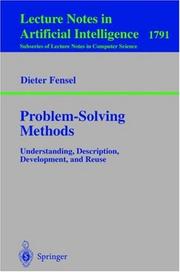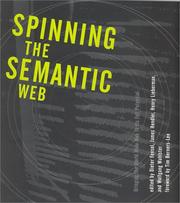| Listing 1 - 10 of 41 | << page >> |
Sort by
|
Book
ISBN: 3642434266 3642197965 3642197973 Year: 2011 Publisher: New York : Springer,
Abstract | Keywords | Export | Availability | Bookmark
 Loading...
Loading...Choose an application
- Reference Manager
- EndNote
- RefWorks (Direct export to RefWorks)
In the mid 1990s, Tim Berners-Lee had the idea of developing the World Wide Web into a „Semantic Web“, a web of information that could be interpreted by machines in order to allow the automatic exploitation of data, which until then had to be done by humans manually. One of the first people to research topics related to the Semantic Web was Professor Rudi Studer. From the beginning, Rudi drove projects like ONTOBROKER and On-to-Knowledge, which later resulted in W3C standards such as RDF and OWL. By the late 1990s, Rudi had established a research group at the University of Karlsruhe, which later became the nucleus and breeding ground for Semantic Web research, and many of today’s well-known research groups were either founded by his disciples or benefited from close cooperation with this think tank. In this book, published in celebration of Rudi’s 60th birthday, many of his colleagues look back on the main research results achieved during the last 20 years. Under the editorship of Dieter Fensel, once one of Rudi’s early PhD students, an impressive list of contributors and contributions has been collected, covering areas like Knowledge Management, Ontology Engineering, Service Management, and Semantic Search. Overall, this book provides an excellent overview of the state of the art in Semantic Web research, by combining historical roots with the latest results, which may finally make the dream of a “Web of knowledge, software and services” come true.
Computer-assisted instruction. --- Distance education. --- Knowledge management. --- Semantic Web --- Keyword searching --- Engineering & Applied Sciences --- Electrical & Computer Engineering --- Telecommunications --- Computer Science --- Semantic Web. --- Keyword searching. --- Free text searching --- Full text searching --- Natural language searching --- Computer science. --- Information technology. --- Business --- Information storage and retrieval. --- Artificial intelligence. --- Application software. --- Computer Science. --- Information Systems Applications (incl. Internet). --- Artificial Intelligence (incl. Robotics). --- Information Storage and Retrieval. --- IT in Business. --- Computer Appl. in Administrative Data Processing. --- Data processing. --- Electronic information resource searching --- Semantic integration (Computer systems) --- Semantic networks (Information theory) --- World Wide Web --- Microformats --- Information storage and retrieva. --- Information systems. --- Artificial Intelligence. --- IT (Information technology) --- Technology --- Telematics --- Information superhighway --- Knowledge management --- AI (Artificial intelligence) --- Artificial thinking --- Electronic brains --- Intellectronics --- Intelligence, Artificial --- Intelligent machines --- Machine intelligence --- Thinking, Artificial --- Bionics --- Cognitive science --- Digital computer simulation --- Electronic data processing --- Logic machines --- Machine theory --- Self-organizing systems --- Simulation methods --- Fifth generation computers --- Neural computers --- Information storage and retrieval systems. --- Automatic data storage --- Automatic information retrieval --- Automation in documentation --- Computer-based information systems --- Data processing systems --- Data storage and retrieval systems --- Discovery systems, Information --- Information discovery systems --- Information processing systems --- Information retrieval systems --- Machine data storage and retrieval --- Mechanized information storage and retrieval systems --- Computer systems --- Electronic information resources --- Data libraries --- Digital libraries --- Information organization --- Information retrieval --- Business—Data processing. --- Application computer programs --- Application computer software --- Applications software --- Apps (Computer software) --- Computer software

ISBN: 3540678166 3540449361 Year: 2000 Publisher: New York, NY ; Berlin : Springer-Verlag,
Abstract | Keywords | Export | Availability | Bookmark
 Loading...
Loading...Choose an application
- Reference Manager
- EndNote
- RefWorks (Direct export to RefWorks)
Researchers in Artificial Intelligence have traditionally been classified into two categories: the “neaties” and the “scruffies”. According to the scruffies, the neaties concentrate on building elegant formal frameworks, whose properties are beautifully expressed by means of definitions, lemmas, and theorems, but which are of little or no use when tackling real-world problems. The scruffies are described (by the neaties) as those researchers who build superficially impressive systems that may perform extremely well on one particular case study, but whose properties and underlying theories are hidden in their implementation, if they exist at all. As a life-long, non-card-carrying scruffy, I was naturally a bit suspicious when I first started collaborating with Dieter Fensel, whose work bears all the formal hallmarks of a true neaty. Even more alarming, his primary research goal was to provide sound, formal foundations to the area of knowledge-based systems, a traditional stronghold of the scruffies - one of whom had famously declared it “an art”, thus attempting to place it outside the range of the neaties (and to a large extent succeeding in doing so).
Expert systems (Computer science) --- Problem solving --- Computer Science --- Engineering & Applied Sciences --- Problem solving. --- Knowledge-based systems (Computer science) --- Systems, Expert (Computer science) --- Computer science. --- Software engineering. --- Artificial intelligence. --- Computer Science. --- Artificial Intelligence (incl. Robotics). --- Software Engineering. --- Methodology --- Psychology --- Decision making --- Executive functions (Neuropsychology) --- Artificial intelligence --- Computer systems --- Soft computing --- Artificial Intelligence. --- AI (Artificial intelligence) --- Artificial thinking --- Electronic brains --- Intellectronics --- Intelligence, Artificial --- Intelligent machines --- Machine intelligence --- Thinking, Artificial --- Bionics --- Cognitive science --- Digital computer simulation --- Electronic data processing --- Logic machines --- Machine theory --- Self-organizing systems --- Simulation methods --- Fifth generation computers --- Neural computers --- Computer software engineering --- Engineering

ISBN: 3540003029 3642055583 366209083X Year: 2004 Publisher: Berlin Springer
Abstract | Keywords | Export | Availability | Bookmark
 Loading...
Loading...Choose an application
- Reference Manager
- EndNote
- RefWorks (Direct export to RefWorks)
Ontologies have been developed and investigated for some time in artificial intelligence to facilitate knowledge sharing and reuse. More recently, the notion of ontologies has attracted attention from fields such as databases, intelligent information integration, cooperative information systems, information retrieval, electronic commerce, enterprise application integration, and knowledge management. This broadened interest in ontologies is based on the feature that they provide a machine-processable semantics of information sources that can be communicated among agents as well as between software artifacts and humans. This feature makes ontologies the backbone technology of the next web generation, i.e., the Semantic Web. Ontologies are currently applied in areas such as knowledge management in large company-wide networks and call centers, and in B2C, B2G, and B2B electronic commerce. In a nutshell, ontologies enable effective and efficient access to heterogeneous and distributed information sources. Given the increasing amount of information available online, this kind of support is becoming more important day by day. The author systematically introduces the notion of ontologies to the non-expert reader and demonstrates in detail how to apply this conceptual framework for improved intranet retrieval of corporate information and knowledge and for enhanced Internet-based electronic commerce. He also describes ontology languages (XML, RDF, and OWL) and ontology tools, and the application of ontologies. In addition to structural improvements, the second edition covers recent developments relating to the Semantic Web, and emerging web-based standard languages. .
Database management. --- Electronic commerce. --- Semantic Web. --- Trade. --- Business. --- Commerce. --- Artificial intelligence. --- Computer science. --- User interfaces (Computer systems). --- E-commerce. --- Information technology. --- Business—Data processing. --- Artificial Intelligence. --- Computer Science, general. --- User Interfaces and Human Computer Interaction. --- e-Commerce/e-business. --- IT in Business. --- IT (Information technology) --- Technology --- Telematics --- Information superhighway --- Knowledge management --- Cybercommerce --- E-business --- E-commerce --- E-tailing --- eBusiness --- eCommerce --- Electronic business --- Internet commerce --- Internet retailing --- Online commerce --- Web retailing --- Commerce --- Interfaces, User (Computer systems) --- Human-machine systems --- Human-computer interaction --- Informatics --- Science --- AI (Artificial intelligence) --- Artificial thinking --- Electronic brains --- Intellectronics --- Intelligence, Artificial --- Intelligent machines --- Machine intelligence --- Thinking, Artificial --- Bionics --- Cognitive science --- Digital computer simulation --- Electronic data processing --- Logic machines --- Machine theory --- Self-organizing systems --- Simulation methods --- Fifth generation computers --- Neural computers --- Trade --- Economics --- Business --- Transportation --- Management --- Industrial management --- Traffic (Commerce) --- Merchants

ISBN: 0585444951 0262256134 1423729439 9780262256131 9780585444956 9780262062329 0262062321 9780262562126 026256212X Year: 2003 Publisher: Cambridge, Mass. : MIT Press,
Abstract | Keywords | Export | Availability | Bookmark
 Loading...
Loading...Choose an application
- Reference Manager
- EndNote
- RefWorks (Direct export to RefWorks)
As the World Wide Web continues to expand, it becomes increasingly difficult for users to obtain information efficiently. Because most search engines read format languages such as HTML or SGML, search results reflect formatting tags more than actual page content, which is expressed in natural language. Spinning the Semantic Web describes an exciting new type of hierarchy and standardization that will replace the current "web of links" with a "web of meaning." Using a flexible set of languages and tools, the Semantic Web will make all available information--display elements, metadata, services, images, and especially content--accessible. The result will be an immense repository of information accessible for a wide range of new applications.This first handbook for the Semantic Web covers, among other topics, software agents that can negotiate and collect information, markup languages that can tag many more types of information in a document, and knowledge systems that enable machines to read Web pages and determine their reliability. The truly interdisciplinary Semantic Web combines aspects of artificial intelligence, markup languages, natural language processing, information retrieval, knowledge representation, intelligent agents, and databases.
World Wide Web. --- Semantic Web. --- W3 (World Wide Web) --- Web (World Wide Web) --- World Wide Web (Information retrieval system) --- WWW (World Wide Web) --- Semantic integration (Computer systems) --- Semantic networks (Information theory) --- World Wide Web --- Microformats --- Hypertext systems --- Multimedia systems --- Internet --- Information systems --- COMPUTER SCIENCE/Human Computer Interaction --- COMPUTER SCIENCE/Artificial Intelligence --- COMPUTER SCIENCE/Computational Linguistics --- 654 --- Informatieverwerking. Bureautica. --- Informatieverwerking. Bureautica
Book
ISBN: 9783642197963 3642197965 Year: 2011 Publisher: New York, N.Y.: Springer,
Abstract | Keywords | Export | Availability | Bookmark
 Loading...
Loading...Choose an application
- Reference Manager
- EndNote
- RefWorks (Direct export to RefWorks)
Semantic web --- Keyword searching --- Keyword searching. --- Semantic Web.
Digital
ISBN: 9783642197970 Year: 2011 Publisher: Berlin, Heidelberg Springer Berlin Heidelberg
Abstract | Keywords | Export | Availability | Bookmark
 Loading...
Loading...Choose an application
- Reference Manager
- EndNote
- RefWorks (Direct export to RefWorks)
Office management --- Information systems --- Artificial intelligence. Robotics. Simulation. Graphics --- Computer. Automation --- ICT (informatie- en communicatietechnieken) --- IR (information retrieval) --- bedrijfseconomie --- informatica --- bedrijfsadministratie --- informatiesystemen --- KI (kunstmatige intelligentie) --- informatica management --- robots --- AI (artificiële intelligentie)
Book
ISBN: 9783540793953 354079395X 9786611398088 128139808X 3540793968 Year: 2008 Publisher: New York : Springer,
Abstract | Keywords | Export | Availability | Bookmark
 Loading...
Loading...Choose an application
- Reference Manager
- EndNote
- RefWorks (Direct export to RefWorks)
This book contains the refereed proceedings of the 11th International Conference on Business Information Systems, BIS 2008, held in Innsbruck, Austria, in May 2008. The 41 revised full papers were carefully reviewed and selected for inclusion in the book. The contributions cover research trends as well as current achievements and cutting edge developments in the area of modern business information systems. They are grouped in sections on business process management, service discovery and composition, ontologies, information retrieval, enterprise resource planning, interoperability, mobility and contexts, wikis and folksonomies, and rules and semantic queries.
Business --- Information storage and retrieval systems --- Data processing --- Business. --- Operations research. --- Decision making. --- Information technology. --- Software engineering. --- Application software. --- E-commerce. --- Business and Management. --- Operation Research/Decision Theory. --- IT in Business. --- Information Systems Applications (incl. Internet). --- Computer Appl. in Administrative Data Processing. --- e-Commerce/e-business. --- Software Engineering. --- Data processing. --- Information systems. --- Operations Research/Decision Theory. --- Computer software engineering --- Engineering --- IT (Information technology) --- Technology --- Telematics --- Information superhighway --- Knowledge management --- Operational analysis --- Operational research --- Industrial engineering --- Management science --- Research --- System theory --- Business—Data processing. --- Cybercommerce --- E-business --- E-commerce --- E-tailing --- eBusiness --- eCommerce --- Electronic business --- Internet commerce --- Internet retailing --- Online commerce --- Web retailing --- Commerce --- Application computer programs --- Application computer software --- Applications software --- Apps (Computer software) --- Computer software --- Deciding --- Decision (Psychology) --- Decision analysis --- Decision processes --- Making decisions --- Management --- Management decisions --- Choice (Psychology) --- Problem solving --- Decision making --- Business information services. --- Information technology --- Electronic commerce. --- Operations Research and Decision Theory. --- Computer and Information Systems Applications. --- Computer Application in Administrative Data Processing. --- e-Commerce and e-Business. --- Management. --- Business enterprises --- Information services
Digital
ISBN: 9783540793960 Year: 2008 Publisher: Berlin, Heidelberg Springer-Verlag Berlin Heidelberg
Abstract | Keywords | Export | Availability | Bookmark
 Loading...
Loading...Choose an application
- Reference Manager
- EndNote
- RefWorks (Direct export to RefWorks)
Office management --- Distribution strategy --- Information systems --- Computer. Automation --- ICT (informatie- en communicatietechnieken) --- bedrijfseconomie --- informatica --- bedrijfsadministratie --- informatiesystemen --- e-commerce --- software engineering --- informatica management
Book
ISBN: 9783031452567 Year: 2024 Publisher: Cham : Springer Nature Switzerland : Imprint: Springer,
Abstract | Keywords | Export | Availability | Bookmark
 Loading...
Loading...Choose an application
- Reference Manager
- EndNote
- RefWorks (Direct export to RefWorks)
This textbook introduces the theoretical foundations of technologies essential for knowledge graphs. It also covers practical examples, applications and tools. Knowledge graphs are the most recent answer to the challenge of providing explicit knowledge about entities and their relationships by potentially integrating billions of facts from heterogeneous sources. The book is structured in four parts. For a start, Part I lays down the overall context of knowledge graph technology. Part II “Knowledge Representation” then provides a deep understanding of semantics as the technical core of knowledge graph technology. Semantics is covered from different perspectives, such as conceptual, epistemological and logical. Next, Part III “Knowledge Modelling” focuses on the building process of knowledge graphs. The book focuses on the phases of knowledge generation, knowledge hosting, knowledge assessment, knowledge cleaning, knowledge enrichment, and knowledge deployment to cover a complete life cycle for this process. Finally, Part IV (simply called “Applications”) presents various application areas in detail with concrete application examples as well as an outlook on additional trends that will emphasize the need for knowledge graphs even stronger. This textbook is intended for graduate courses covering knowledge graphs. Besides students in knowledge graph, Semantic Web, database, or information retrieval classes, also advanced software developers for Web applications or tools for Web data management will learn about the foundations and appropriate methods.
Artificial intelligence. --- Information storage and retrieval systems. --- Expert systems (Computer science). --- Natural language processing (Computer science). --- Artificial Intelligence. --- Information Storage and Retrieval. --- Knowledge Based Systems. --- Natural Language Processing (NLP).
Multi
ISBN: 9783031452567 9783031452550 9783031452574 Year: 2024 Publisher: Cham : Springer Nature Switzerland : Imprint: Springer,
Abstract | Keywords | Export | Availability | Bookmark
 Loading...
Loading...Choose an application
- Reference Manager
- EndNote
- RefWorks (Direct export to RefWorks)
This textbook introduces the theoretical foundations of technologies essential for knowledge graphs. It also covers practical examples, applications and tools. Knowledge graphs are the most recent answer to the challenge of providing explicit knowledge about entities and their relationships by potentially integrating billions of facts from heterogeneous sources. The book is structured in four parts. For a start, Part I lays down the overall context of knowledge graph technology. Part II “Knowledge Representation” then provides a deep understanding of semantics as the technical core of knowledge graph technology. Semantics is covered from different perspectives, such as conceptual, epistemological and logical. Next, Part III “Knowledge Modelling” focuses on the building process of knowledge graphs. The book focuses on the phases of knowledge generation, knowledge hosting, knowledge assessment, knowledge cleaning, knowledge enrichment, and knowledge deployment to cover a complete life cycle for this process. Finally, Part IV (simply called “Applications”) presents various application areas in detail with concrete application examples as well as an outlook on additional trends that will emphasize the need for knowledge graphs even stronger. This textbook is intended for graduate courses covering knowledge graphs. Besides students in knowledge graph, Semantic Web, database, or information retrieval classes, also advanced software developers for Web applications or tools for Web data management will learn about the foundations and appropriate methods.
Information retrieval --- Information systems --- Artificial intelligence. Robotics. Simulation. Graphics --- Computer. Automation --- NLP (neurolinguïstisch programmeren) --- KBS (knowledge based system) --- informatiesystemen --- AI (artificiële intelligentie) --- Artificial intelligence. --- Information storage and retrieval systems. --- Expert systems (Computer science). --- Natural language processing (Computer science). --- Artificial Intelligence. --- Information Storage and Retrieval. --- Knowledge Based Systems. --- Natural Language Processing (NLP). --- Expert systems (Computer science) --- Natural language processing (Computer science)
| Listing 1 - 10 of 41 | << page >> |
Sort by
|

 Search
Search Feedback
Feedback About UniCat
About UniCat  Help
Help News
News